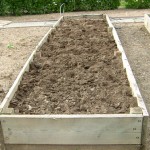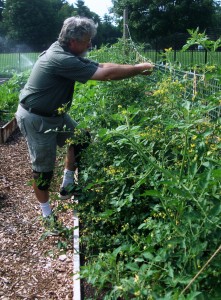The Case for Raised Bed Gardening
 Do you have bad soil? Do you want to garden over tree roots? Do you want a vegetable garden that you don’t need to re-till each year? Do you want a garden you can tend without getting on your knees? Try a raised bed.
Do you have bad soil? Do you want to garden over tree roots? Do you want a vegetable garden that you don’t need to re-till each year? Do you want a garden you can tend without getting on your knees? Try a raised bed.
What are raised beds? Raised beds are gardens created by making the soil level several inches – or feet—above the height of the surrounding ground. Bed implies the area is small enough to work without stepping into the garden. It can be simply soil piled up to the desired height or the soil can be enclosed by a wall of wood, rocks or masonry. A raised bed should be no more than 3 to 4 feet wide. Its length can be whatever fits the site and gardener’s needs. If the gardener can’t bend or needs to work sitting down, raised beds can be created at waist height. By enclosing the bed with a frame, and working only from the outside, you eliminate walking through the bed, compacting the soil with your feet. Therefore there is no need for tilling the soil each year.
When a raised bed is built, you control the content of the soil. When you want to be certain you are growing vegetables in clean organic soil, you chose the composition. As a rule, the bed should be filled with a mixture of good soil and clean organic matter such as compost or well aged animal manure. A fresh layer of organic material laid down each year in the fall or early spring keeps the bed easy to work and highly productive.
Because there are no paths inside the bed and the soil is uncompacted, water, air and roots all move easily through the soil greatly increasing how many plants can be productively grown in a space. Studies have shown that this means that a raised garden can produce more than three times the vegetables than could be grown in the same area of a traditional garden. Further the gardener can begin earlier because raised beds warm up more quickly in the spring than in-ground gardens. Because the beds are fairly narrow, you can use garden cloth or plastic to provide spring and fall frost protection. In summer you can add shade for crops like lettuce which might otherwise bolt in the hot sun.
The soil is a raised bed will also drain more quickly than from surrounding ground. You may be able to begin planting the beds even when the rest of your garden is too wet to work. This, however, may also mean you will have to water more often in the summer. But because plants are closer together, they shade the soil, reducing the number of weeds and reducing evaporation from sunlight and wind, the watering will be less than that in a comparably productive garden. Soaker hoses and drip irrigation both minimize the time it takes gardener to care for her bed.
